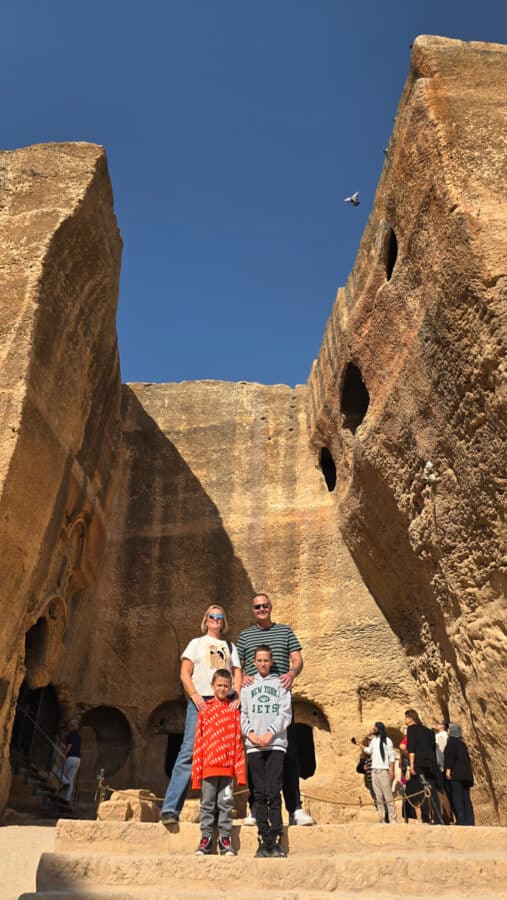There’s something very special about exploring historical sites. They give you a window into the amazing times that have passed. Of course, some are better than others, but one that really captures the attention is Dara.
Nestled in Southeastern Turkey, Dara was once a bustling Byzantine frontier town. It was pivotal in the stories of wars, empires, and civilizations that dared to claim this strategic spot. But what is there to see and do there? Is it worthwhile? Let’s explore!

Skip Ahead To My Advice Here!
What Is The Ancient City Of Dara?

The ancient ruins of Dara, known initially as Anastasiopolis, are indeed a marvel. A Byzantine fortress city, Dara holds a special place in history books due to its strategic military significance during the Roman and Byzantine periods.
The intriguing part about Dara is that it offers a peek into the architectural and engineering prowess of the time. For instance, the city had complex water supply systems and impressive cisterns that are still visible and quite striking. These ancient engineering feats always make me marvel at how advanced societies were back then, even without modern technology!
One of the most captivating sights at Dara is the necropolis, which is filled with large, elaborately carved rock-cut tombs. It’s like stepping back into a time machine and getting a somber, fascinating glimpse into past funeral practices.
Further adding to Dara’s charm are the remains of various churches and a large number of residential structures, some with intact mosaic floors that hint at the lives of those who once lived there. It really makes you wonder about the daily lives of the ancient inhabitants, doesn’t it?
How To Get To Dara City

To get to Dara, your journey starts in the city of Mardin, which is well-connected by air with flights from major Turkish cities like Istanbul and Ankara.
From Mardin, Dara is about a 30-kilometer drive away. You can rent a car, which allows you to explore the surrounding areas at your own pace, or you can opt for a local taxi. Occasional tour buses also travel that way, providing a more guided and informative experience.
The road to Dara offers picturesque views and a gradual unveiling of the landscape’s deeper, rugged beauty. As you get closer, it’s not hard to imagine the bustling activity that once filled this outpost of the Byzantine Empire—soldiers, merchants, and travelers mingling and going about their daily business.
What Is The Entrance Fee When Visiting Dara?
Nothing! Can you believe that? Visiting the Ancient Ruins of Dara is entirely free.
The History Of Dara, Near Mardin

The ancient ruins of Dara, near the modern-day town of Oğuz, are a fascinating testament to the region’s rich history. Established during the Byzantine period around the 6th century AD, Dara was once a bustling frontier town and military stronghold that played a pivotal role in the empire’s defenses against Persian forces. It’s an intriguing site, truly – a window into an era of sword-clashing empires and strategic fortifications.
Originally named after Darius, a Persian king, Dara was part of a defense line against Sassanid Persia, an area always on the ready, bristling with the anticipation of warfare. Imagine the hustle and bustle of soldiers and strategists, all moving through this town fortified with massive walls and towers crafted with the expertise only those ancient architects could muster. Its location was nothing short of strategic genius. It was on the Mesopotamian plain, ensuring it was the perfect sentinel over one of the few passable routes between the Taurus mountains and the Syrian plateau.
One of Dara’s most remarkable features is its complex water management system. The ancients constructed an elaborate network of cisterns that could store vast amounts of water, a crucial innovation in such a parched landscape. These cisterns were engineering marvels of their time and underscored the ingenuity of the town’s inhabitants, who, despite the harsh, arid climate, managed to create a flourishing settlement.
Moreover, the necropolis of Dara, where the ruins include a myriad of rock-cut tombs, tells the tale of a civilization deeply rooted in their traditions and beliefs about the afterlife. These tombs, some adorned with detailed reliefs, offer us glimpses into the cultural and artistic sensibilities of the era, providing valuable insights into the spiritual lives of its people in the context of the Roman Empire.
Excavations at Dara have unearthed not just everyday objects and structures but also spectacular remnants that speak to the site’s strategic importance and cultural wealth. For instance, an ancient synagogue has been discovered, pointing to the once vibrant, diverse community that lived here, coexisting amid the frequent conflicts of the era.
Today, the ruins of Dara stand somewhat quietly, overshadowed perhaps by more renowned ancient sites, but they remain a profoundly compelling portal into the past. They tell a story of a strategic military post, a vibrant community, and brilliant hydraulic engineering, capturing the imagination of historians and tourists alike. For those who take the time to visit or study Dara, the ruins are not just ancient stones; they are the echoes of the footsteps of soldiers, the whispers of ancient strategists, and the resilience of a once-thriving city.
Brands We Use And Trust
Things To See & Do At The Dara Ruins
If you love ancient history or are just someone curious to explore the echoes of the past, the ruins of Dara in southeastern Turkey provide a fascinating glimpse into bygone eras. Here’s a detailed guide on what to see and do when you visit this intriguing site.
1. Explore The Necropolis

Start your adventure at the hauntingly beautiful necropolis of Dara. This ancient cemetery features a collection of remarkable rock-cut tombs dating back to the early Byzantine period.

Each tomb has a unique architectural style. Some are adorned with meticulous reliefs and inscriptions that provide a window into the lives and times of those interred within.
It’s like a history book but carved in stone!
2. Marvel At The Water Cisterns

One of the most astonishing engineering feats at Dara is the network of enormous underground water cisterns. These were constructed to store water for the city’s residents and protect them during sieges.

You can descend into these cavernous spaces and walk through the arched tunnels – a cool respite on a hot day and a profound connection to ancient ingenuity.
3. Check Out The Fortress And City Walls

No visit to Dara would be complete without a walk around the remnants of the fortress and the formidable city walls. While they may now be partially in ruins, their impressive scale and construction give a good indication of the city’s strategic importance.
Climb the sections where it’s safe, and you’ll be rewarded with panoramic views of the surrounding countryside.
4. Visit The Church Ruins

The remains of several Byzantine churches are scattered around the site. Although these ruins are less ornate than the grand basilicas found in more prominent cities of the empire, they offer a serene charm and a peek into the era’s religious life.
Particularly noteworthy is the architectural style, which reflects both Eastern and Western influences typical of the region at that time.
5. Witness The Archaeological Dig

If you’re lucky, your visit might coincide with ongoing archaeological excavations. Dara’s layered history means that it’s a continual site of discovery for historians and archaeologists.
Observing them as they carefully unearth relics is like watching detectives crack a centuries-old case. Who knows what they might find next?
6. Enjoy The Landscape

Finally, take a moment to enjoy the landscape around Dara. The rolling hills and rugged terrain add a natural beauty to the site and offer a perfect backdrop for your explorations.
It’s an excellent place for photography, meditation, or just sitting back and imagining the bustling ancient city that once stood there.
Dara Mesopotamia FAQs
What is Dara, and why is it significant?
Dara, also known as Anastasiopolis, is a historical archaeological site in Mardin Province, southeastern Turkey, located near the modern village of Oğu.
Established in the 6th century as a military outpost by the Byzantine Empire, Dara was once considered the easternmost stronghold of the empire. It played a pivotal role in defending against the Sassanian Empire and later Islamic armies.
How can I get to Dara?
Dara is accessible from the city of Mardin, which is well-served by domestic flights and buses from various parts of Turkey. From Mardin, you can hire a taxi or take a local dolmuş (shared taxi/minibus) directly to the ruins. The journey typically takes around 30 minutes.
What are the operating hours and admission fees for the historical sites in the ancient city of Dara?
The ruins of Dara are usually open to visitors daily from 8:00 AM to 7:00 PM in the summer and from 8:00 AM to 5:00 PM in the winter. There is currently no admission fee, but it’s advisable to check the latest information as these details can change.
What should I bring with me when visiting Dara?
It’s wise to wear comfortable walking shoes, as the terrain around the ruins can be uneven. Also, bring water, sun protection (hat, sunscreen), and possibly a snack. Since there are limited facilities nearby, it’s best to be prepared with necessities before you arrive.
Can I take guided tours of Dara?
While there may not always be official guided tours available through the site itself, local guides are often present at or near the entrance. Hiring a knowledgeable local guide can enrich your experience, providing historical context and pointing out details you might otherwise miss.
Alternatively, you can book a tour through a travel agency in Mardin.
What are some must-see features at Dara?
Don’t miss the ancient water cisterns in Dara, which are engineering marvels reminiscent of innovations from the Roman Empire. The necropolis, with its rock-cut tombs, offers a fascinating insight into the burial practices and beliefs of the time. The fortress and city walls are also impressive for their construction and historical significance.
Are there any restrictions or cultural considerations to be aware of?
As is customary in many historical sites worldwide, it’s essential to respect the site by not climbing on delicate structures or removing artifacts. Keep in mind that the local culture is predominantly conservative, so it’s recommended that you dress modestly.
Is photography allowed in Dara?
Photography for personal use is generally allowed and encouraged; however, commercial photography might require special permissions. Always respect signage and the requests of site staff regarding restricted areas or times.
Are there facilities like restrooms or a café at the site?
Basic facilities like restrooms are available, but food and drink options are limited. Consider visiting the local village or bringing your own refreshments.
What is the best time of year to visit Dara?
The region can be very hot in the summer months, so visiting in the spring or fall is ideal when the temperatures are milder, and the landscape is lush and inviting.

